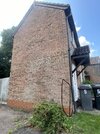Hello,
We brought this house around a year ago. Built in 1990’s. The other week I noticed a rather long hairline crack running up the corner of the house. Runs from the bottom, through DPM and through around 12 bricks… The previous owner has planted a decent sized shrub that has a fairly thick trunk and also our guttering down pipe is close to the crack. Wondering if this could be main cause. Hoping it not to be subsidence. Also would it be worth re-pointing, epoxying / waterproofing for the time being to give it a chance of not escalating quickly and needing significant repair work
Thanks


We brought this house around a year ago. Built in 1990’s. The other week I noticed a rather long hairline crack running up the corner of the house. Runs from the bottom, through DPM and through around 12 bricks… The previous owner has planted a decent sized shrub that has a fairly thick trunk and also our guttering down pipe is close to the crack. Wondering if this could be main cause. Hoping it not to be subsidence. Also would it be worth re-pointing, epoxying / waterproofing for the time being to give it a chance of not escalating quickly and needing significant repair work
Thanks


